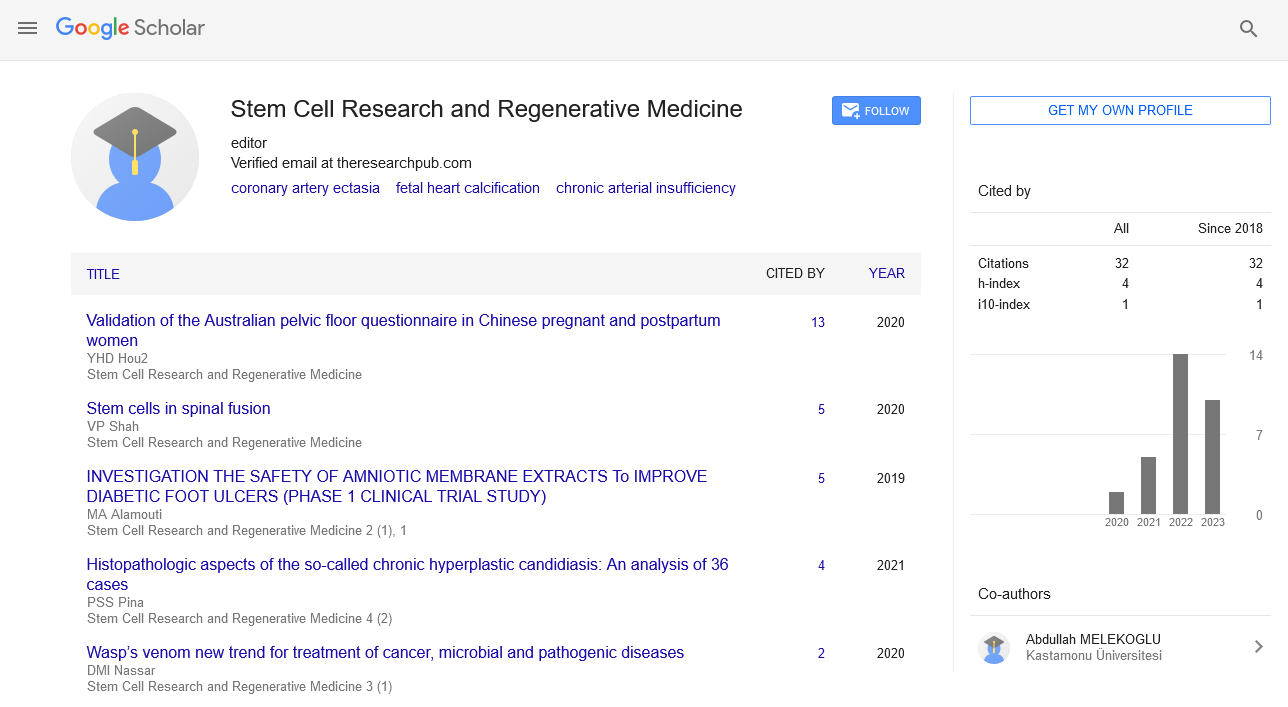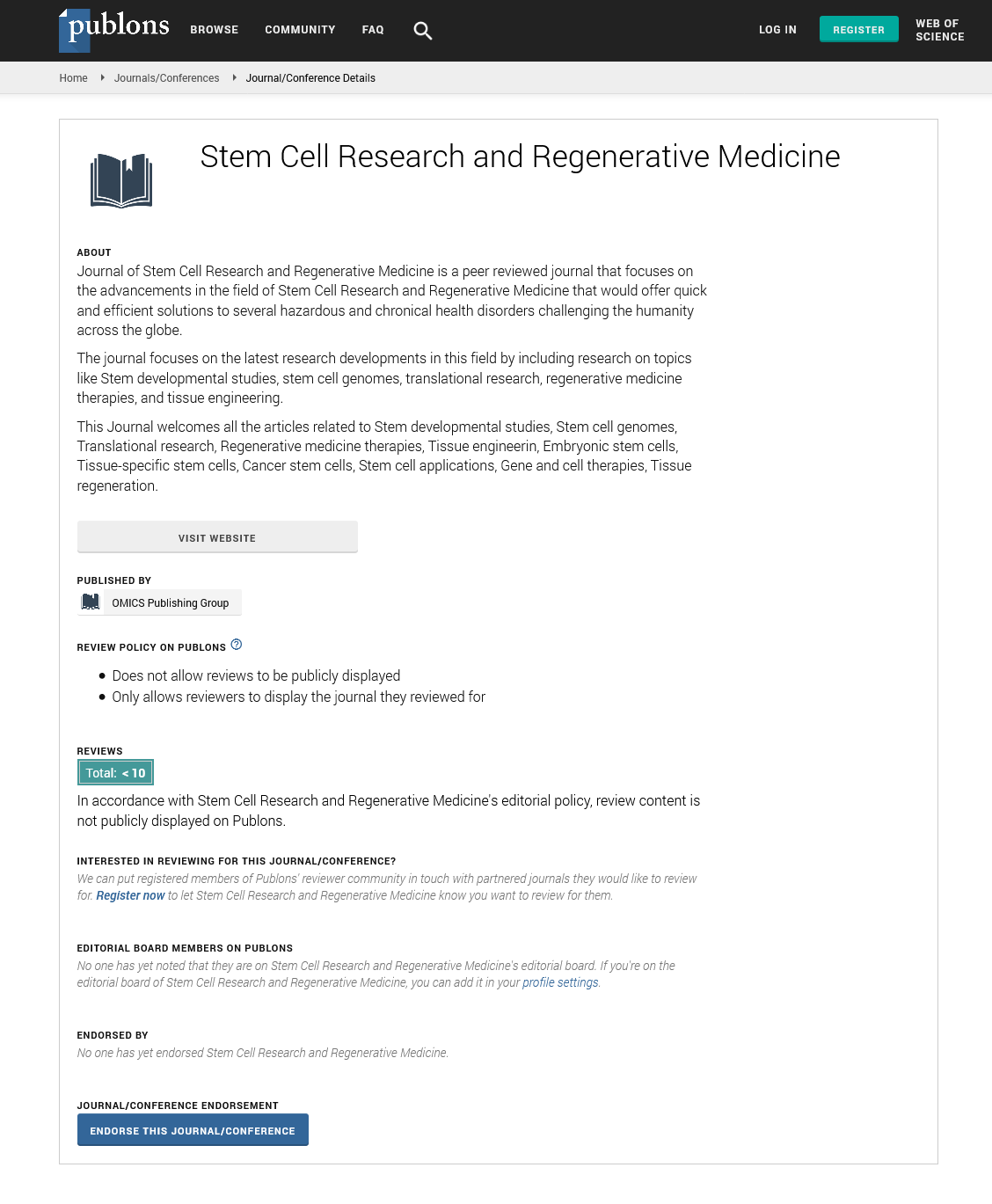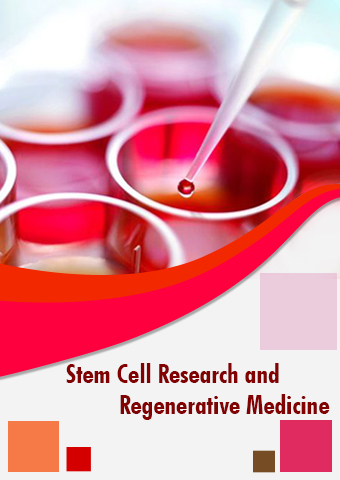Opinion Article - Stem Cell Research and Regenerative Medicine (2024) Volume 7, Issue 3
Beta Cells in Diabetes: Challenges and Prospects for Regeneration and Replacement Therapies
- Corresponding Author:
- Carlos Eduardo Ambrosio
Department of Cell Biology,
University of Lubumbashi,
Lubumbashi,
Congo
E-mail: CarlosEA@usp.br
Received: 29-May-2024, Manuscript No. SRRM-24-137543; Editor assigned: 31-May-2024, Pre QC No. SRRM-24-137543 (PQ); Reviewed: 12-Jun-2024, QC No. SRRM-24-137543; Revised: 21-Jun-2024, Manuscript No. SRRM-24-137543 (R); Published: 28-Jun-2024, DOI: 10.37532/ SRRM.2024.7(3).206-208
Introduction
Beta cells, located in the islets of Langerhans in the pancreas, play a crucial role in maintaining glucose homeostasis by secreting insulin in response to blood glucose levels. Insulin is essential for glucose uptake by cells, and its deficiency or dysfunction is a hallmark of diabetes mellitus. Diabetes, a chronic condition characterized by hyperglycemia, is primarily classified into Type 1 Diabetes (T1D) and Type 2 Diabetes (T2D), both of which involve beta cell dysfunction or loss. This article explores the challenges associated with beta cell failure, the prospects for beta cell regeneration and replacement therapies, and the potential for future advancements in diabetes treatment.
Description
In T1D, an autoimmune response targets and destroys beta cells, leading to an absolute insulin deficiency. Patients with T1D require lifelong insulin replacement therapy to manage blood glucose levels. The onset of T1D often occurs in childhood or adolescence, and its management involves regular blood glucose monitoring and insulin administration, which can be burdensome and does not fully mimic the physiological regulation of insulin secretion. Efforts to develop therapies that can replace or regenerate beta cells hold promise for more effective and durable treatment options.
In T2D, beta cells initially compensate for insulin resistance in peripheral tissues by increasing insulin secretion. However, over time, beta cells become dysfunctional and fail to maintain adequate insulin production, leading to hyperglycaemia. The progressive nature of beta cell failure in T2D underscores the need for therapeutic strategies that can preserve or restore beta cell function. Unlike T1D, T2D is often associated with obesity, sedentary lifestyle, and genetic predisposition, complicating its management and highlighting the importance of addressing both insulin resistance and beta cell dysfunction.
One of the most promising approaches for treating diabetes involves the regeneration or replacement of beta cells. Regenerative medicine aims to restore the function of damaged tissues or organs, and in the context of diabetes, this could mean regenerating functional beta cells within the pancreas. Several strategies are being explored to achieve this goal, including stimulating endogenous beta cell proliferation, trans differentiation of other cell types into beta cells, and transplantation of beta cells derived from stem cells.
Stimulating the proliferation of existing beta cells within the pancreas is a potential strategy for regenerating beta cell mass. Research has identified several growth factors, signaling pathways, and small molecules that can promote beta cell proliferation. For example, the Wnt signaling pathway, which is involved in cell proliferation and differentiation, has been shown to play a role in beta cell regeneration. Additionally, molecules such as GLP-1 (Glucagon-Like Peptide-1) and its analogs, which are already used in diabetes treatment for their insulin tropic effects, have been found to stimulate beta cell proliferation. However, the challenge remains to induce significant and sustained beta cell proliferation in humans without adverse effects such as tumorigenesis.
Trans differentiation, or reprogramming of other pancreatic cell types into beta cells, represents another innovative approach. Pancreatic alpha cells, which produce glucagon, share a common progenitor with beta cells and retain some plasticity. Studies have demonstrated that manipulating specific transcription factors, such as PDX1, NGN3, and MAFA, can induce alpha cells to trans differentiate into beta cells. This approach could potentially provide a renewable source of beta cells within the pancreas. However, the efficiency and stability of reprogrammed beta cells, as well as the risk of unintended effects on other pancreatic functions, need to be carefully evaluated.
Stem cell-derived beta cells offer a promising avenue for beta cell replacement therapy. Pluripotent Stem Cells (PSCs), including Embryonic Stem Cells (ESCs) and induced Pluripotent Stem Cells (iPSCs), can differentiate into any cell type, including beta cells. Significant progress has been made in generating functional beta cells from PSCs in vitro. These stem cellderived beta cells have been shown to respond to glucose and secrete insulin, offering potential for transplantation into diabetic patients. The transplantation of stem cell-derived beta cells encapsulated in a protective device to prevent immune rejection is currently being explored in clinical trials. While this approach holds great promise, challenges such as ensuring long-term functionality, avoiding immune rejection, and addressing ethical concerns related to the use of stem cells must be addressed.
Pancreatic islet transplantation is another established method for beta cell replacement. This procedure involves transplanting islets from a deceased donor into a diabetic patient. Islet transplantation can restore endogenous insulin production and improve glucose control in patients with T1D. However, the limited availability of donor islets, the need for lifelong immunosuppression to prevent rejection, and the gradual loss of graft function over time are significant challenges. Innovations in immunomodulation and the development of islet encapsulation techniques to protect transplanted cells from immune attack are being investigated to overcome these hurdles.
Gene editing technologies, such as CRISPR/ Cas9, offer new possibilities for treating diabetes by correcting genetic defects that cause beta cell dysfunction or by enhancing beta cell regeneration. For example, gene editing could be used to correct mutations in the insulin gene or to modify beta cells to enhance their resistance to autoimmune attack in T1D.
Additionally, gene editing could be applied to stem cells to improve the efficiency and safety of beta cell differentiation. While gene editing holds great potential, ethical considerations, offtarget effects, and the delivery of gene-editing components to target cells need to be thoroughly addressed.
The immune-mediated destruction of beta cells in T1D presents a unique challenge that requires targeted immune therapies. Strategies to induce immune tolerance, such as regulatory T cell therapy, vaccination with beta cell antigens, and the use of immune checkpoint inhibitors, are being explored. These approaches aim to modulate the immune response to preserve residual beta cells and prevent further autoimmune attack. Combining immune therapies with beta cell regeneration or replacement strategies could offer a comprehensive approach to treating T1D.
In T2D, addressing both insulin resistance and beta cell dysfunction is critical. Lifestyle interventions, including diet and exercise, are fundamental in managing insulin resistance. Pharmacological agents, such as metformin, thiazolidinedione’s, and SGLT2 inhibitors, are used to improve insulin sensitivity and lower blood glucose levels. Additionally, incretin-based therapies, such as GLP-1 receptor agonists and DPP-4 inhibitors, not only enhance insulin secretion but also have protective effects on beta cells. Novel therapeutic targets, such as the inhibition of glucagon secretion and the modulation of the gut micro biome, are being investigated to address the multifactorial nature of T2D.
The development of advanced technologies, such as bioengineered tissues and organs, holds promise for the future of beta cell replacement therapy. Tissue engineering approaches aim to create functional pancreatic tissues or islets using biomaterials, stem cells, and growth factors. These bioengineered constructs could potentially be transplanted into diabetic patients to restore insulin production. Additionally, the use of 3D bio printing to fabricate pancreatic tissues with precise architecture and cell composition is an emerging area of research.
Conclusion
Beta cells are central to the pathophysiology of diabetes, and their regeneration or replacement offers a promising avenue for treatment. While significant progress has been made in understanding beta cell biology and developing therapeutic strategies, several challenges remain.
Stimulating endogenous beta cell proliferation, reprogramming other cell types, deriving beta cells from stem cells, and improving islet transplantation techniques are all active areas of research. Gene editing and immune therapies offer new possibilities for addressing the underlying causes of beta cell dysfunction in diabetes. Future advancements in these areas, combined with innovative technologies and a comprehensive understanding of diabetes pathogenesis, hold the potential to transform the treatment landscape for diabetes and improve the lives of millions of patients worldwide.


